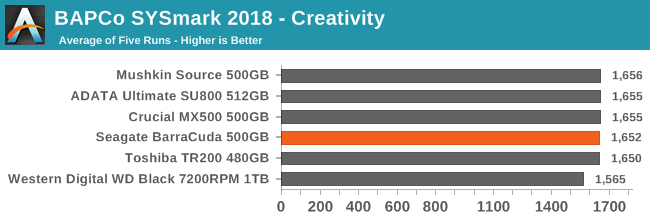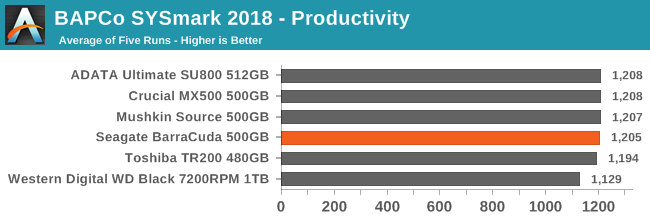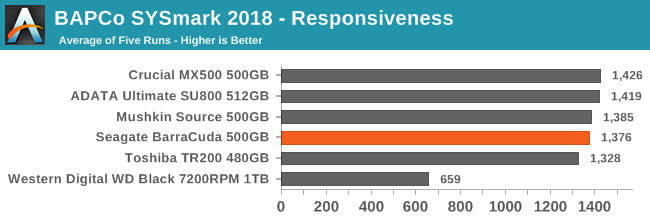The Seagate BarraCuda (500GB) SSD Review: Getting Back In The Game
by Billy Tallis on December 7, 2018 8:00 AM ESTWhole-Drive Fill
This test starts with a freshly-erased drive and fills it with 128kB sequential writes at queue depth 32, recording the write speed for each 1GB segment. This test is not representative of any ordinary client/consumer usage pattern, but it does allow us to observe transitions in the drive's behavior as it fills up. This can allow us to estimate the size of any SLC write cache, and get a sense for how much performance remains on the rare occasions where real-world usage keeps writing data after filling the cache.
 |
|||||||||
The SATA bottleneck renders the SLC caching behavior of the Seagate BarraCuda largely irrelevant for sequential writes. Aside from a momentary blip around the 4GB mark, the BarraCuda stays near the limits of the SATA link for the entire drive filling process.
 |
|||||||||
| Average Throughput for last 16 GB | Overall Average Throughput | ||||||||
The Seagate BarraCuda isn't quite able to match the fastest SATA SSDs for sustained write speed, but it is less than 5% slower. Drives with Silicon Motion's 4-channel SATA SSD controllers have shown that there's no real need for 8-channel controllers in the SATA space anymore, but the 8-channel design of the Phison S10 does convey some fringe benefits as seen here.
BAPCo SYSmark 2018
BAPCo's SYSmark 2018 is an application-based benchmark that uses real-world applications to replay usage patterns of business users, with subscores for productivity, creativity and responsiveness. Scores represnt overall system performance and are calibrated against a reference system that is defined to score 1000 in each of the scenarios. A score of, say, 2000, would imply that the system under test is twice as fast as the reference system.
SYSmark scores are based on total application response time as seen by the user, including not only storage latency but time spent by the processor. This means there's a limit to how much a storage improvement could possibly increase scores, because the SSD is only in use for a small fraction of the total test duration. This is a significant difference from our ATSB tests where only the storage portion of the workload is replicated and disk idle times are cut short to a maximum of 25ms.
| AnandTech SYSmark SSD Testbed | |
| CPU | Intel Core i5-7400 |
| Motherboard | ASUS PRIME Z270-A |
| Chipset | Intel Z270 |
| Memory | 2x 8GB Corsair Vengeance DDR4-2400 CL17 |
| Case | In Win C583 |
| Power Supply | Cooler Master G550M |
| OS | Windows 10 64-bit, version 1803 |
Our SSD testing with SYSmark uses a different test system than the rest of our SSD tests. This machine is set up to measure total system power consumption rather than just the drive's power.



The Seagate BarraCuda provides adequate performance for the CPU and memory-bound Creativity and Productivity scenarios, but on the Responsiveness test it comes up a bit short of what a mainstream SATA SSD should deliver. Instead, it scores more in line with the DRAMless SATA SSDs, which is still far better than a 7200RPM hard drive.
Energy Usage
The SYSmark energy usage scores measure total system power consumption, excluding the display. Our SYSmark test system idles at around 26 W and peaks at over 60 W measured at the wall during the benchmark run. SATA SSDs seldom exceed 5 W and idle at a fraction of a watt, and the SSDs spend most of the test idle. This means the energy usage scores will inevitably be very close. A typical notebook system will tend to be better optimized for power efficiency than this desktop system, so the SSD would account for a much larger portion of the total and the score difference between SSDs would be more noticeable.

The overall system energy usage during SYSmark is reasonably low for the Seagate BarraCuda, indicating that the slightly lower performance of the BarraCuda doesn't add much to the overall runtime of the test. The good active idle power management (see page 9) also contributes to this good score.










39 Comments
View All Comments
seamonkey79 - Friday, December 7, 2018 - link
The caddy would adapt an m.2 to a full 2.5" SATA socket, so you would have an m.2 in a chassis adapting it to 2.5" & classic SATA.That being said, I can't see that doing anything but increasing costs, though having one primary line to manufacture m.2 and the little bit of work needed to adapt an m.2 SATA drive to 2.5", it *could* see some benefit to the manufacturer.
Death666Angel - Friday, December 7, 2018 - link
Huh? M.2 SATA doesn't overheat, that's M.2 NVME/PCIe (which is a bit more difficult to adapt to 2.5" SATA, so I don't care as much). 2.5" SATA drives already have tiny PCBs. They are already bottlenecked by the protocol. With them being M.2 in a 2.5" caddy, they can serve double purpose. I just bought an M.2 drive and a caddy for my Fujitsu T904 laptop, which still has only a 2.5" slot. But I know when that laptop is gone, I'm not gonna need a 2.5" drive. That M.2 drive can be converted into all kinds of useful devices, small desktops, laptops, USB thumb drive. It'd cost them a couple dozens of cents more to manufacture, would it'd be soo much more useful. :D Eventually, more people will use M.2 SATA than 2.5". At least those who buy standalone drives.CheapSushi - Saturday, December 8, 2018 - link
Dragonstongue I don't think you really know what the OP is talking about, just how tiny the PCB seems to be on newer 2.5" SSDs, thus just being a whole lot of waste of space anyway and/or you don't realize adapters already exist and/or don't realize M.2 is just a formfactor and can be NVMe/PCIe or AHCI/SATA. There's always someone who confidently posts a "neg" at a suggestion without even knowing hardware much in the first place.dgingeri - Friday, December 7, 2018 - link
When I was a systems admin for a server software test lab, we received a set (108) of 3TB Seagate Constellation ES.2 SAS drives for a new prototype appliance that would eventually become the DXi6900 series. I was pretty excited to see the new hardware come in, so I got things set up within a day.The test team wasn't ready to test for another week. In that week, we had 12 of those drives go bad. By two months into the project, every single Seagate drive had gone bad. (These are their enterprise level drives, which are supposed to have better reliability.) We ended up requesting a different brand drive from NetApp (the maker of the storage portion of the DXi6900) because of these problems. We replaced them with HGST 4TB drives, and didn't have a single one fail up to the point when I left over two years later.
In the years leading up to that, I had bought several Seagate drives, including 4 1TB drives, 2 2TB drives, and one 3TB drive, and had the drive fail within warranty in EVERY SINGLE CASE. That was specifically why I quit buying them, and the 3TB drive is the last Seagate drive I am ever going to buy intentionally.
This just might be a decent crive, and if Seagate were to put a concerted effort into improving their reliability, they might be something I'd consider. However, as things stand, Seagate and Toshiba are on my NEVER BUY list, along side Biostar, ECS, and Gigabyte.
CheapSushi - Saturday, December 8, 2018 - link
What does this have to do with SSDs at all? Seriously? This is just some overreaching rant saying that one specific type of product means that ALL their products are a problem. Especially about spinning rust several years old; even BackBlaze doesn't use those. Have you even bothered to look into reliability statistics/information on even consumer TLC drives? It's so odd to see people who claim to be in tech but are so antiquated in their knowledge.gglaw - Sunday, December 9, 2018 - link
Quite a humorous post from someone with a supposed heavy tech/admin background but so short-sighted on the big picture. He lists a bad experience from a completely unrelated product line likely not even sharing manufacturing or R&D ties in any way making him ban products from some of the largest tech companies in the world with for the most part tremendous track records. Even if it is in "principle" for how the company leaders model their QC, all the executives making these decisions at the time of the archaic hard drive problems are likely working with other companies by now (pretty good chance for one of his "new" favorite companies). Similar to the comments on some of Samsung's early SSD fiascos banning all Samsung products "for life." And of course shortly after their fiascos, they quickly became essentially the world's benchmark for performance and reliability in this same product line lol.Donkey2008 - Thursday, December 13, 2018 - link
108 enterprise-class hard drives failed in 2 months?[Insert Doubt meme]
sarahkevin - Friday, December 7, 2018 - link
thanks for sharing I really need this for my office.PeachNCream - Friday, December 7, 2018 - link
I think I'd probably opt for a Crucial MX500 over a Seagate SSD. Seagate's reputation and my experiences with their mechanical drives make me reluctant about giving them yet another chance.Fujikoma - Friday, December 21, 2018 - link
I feel the same way about Quantum SCSI drives. Not that Seagate rates much higher...